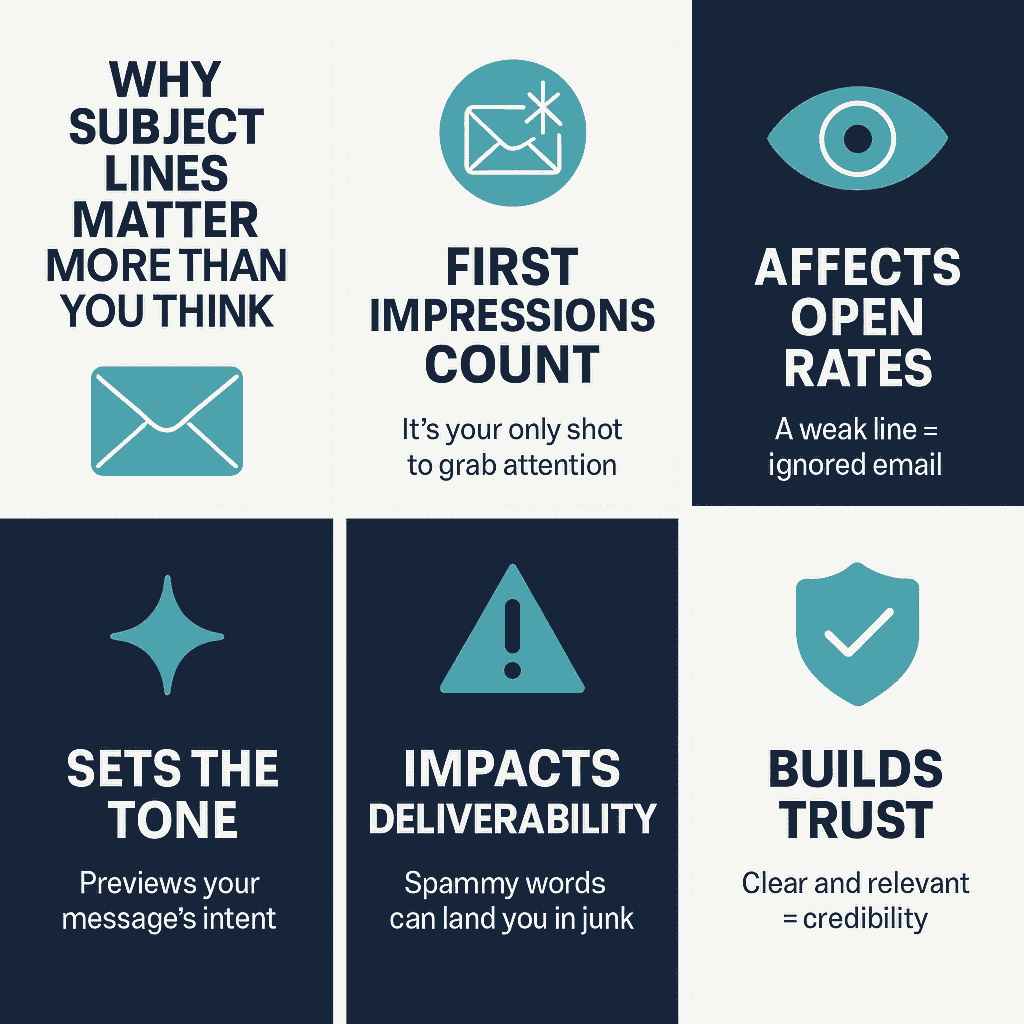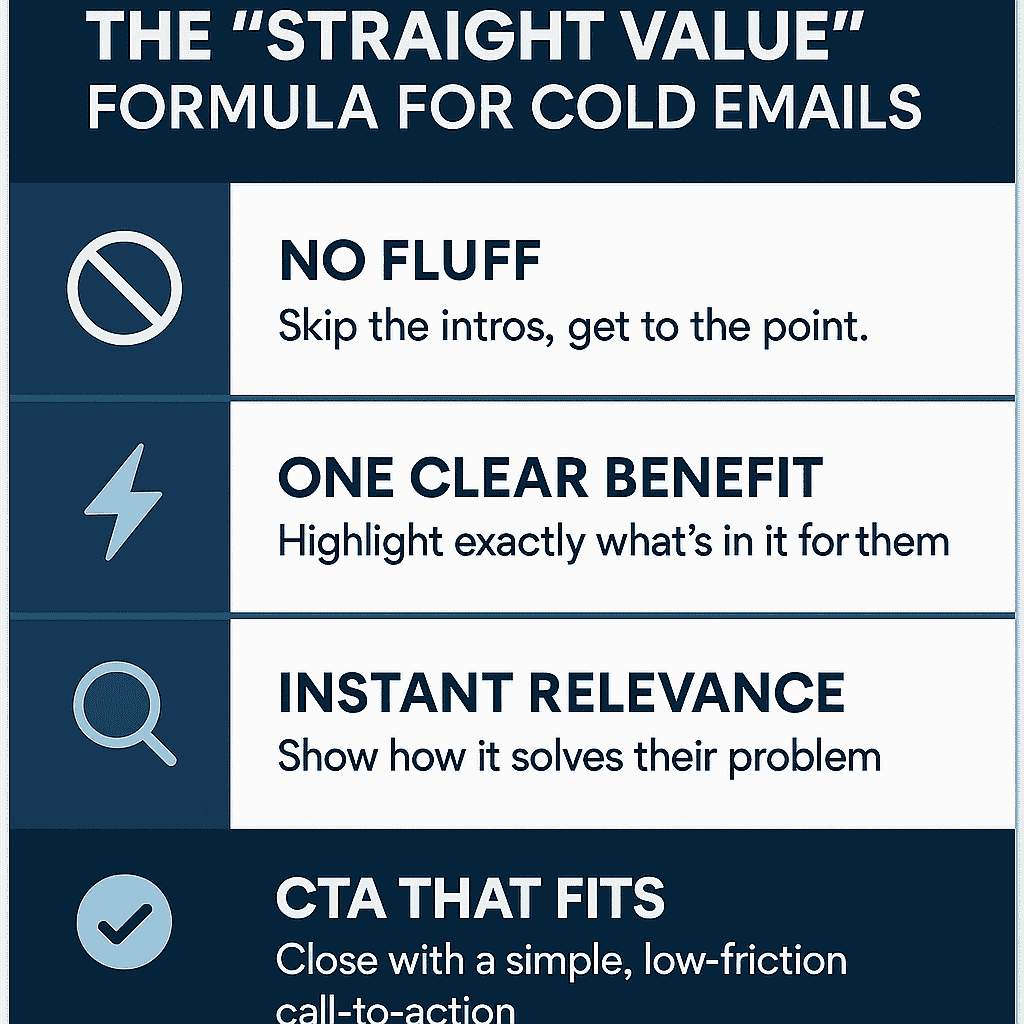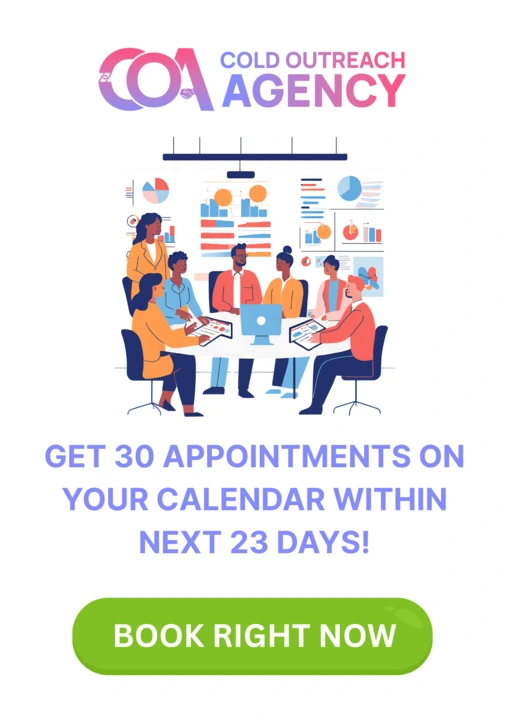Let’s be honest—if the subject line doesn’t hit, the rest of your cold email might as well not exist. I’ve tested hundreds of subject lines in my cold outreach campaigns, and I’ve seen firsthand how just tweaking a few words can double (or destroy) your open rates. It’s that crucial.
And I know what you’re thinking—“It’s just one line!” But that one line is the gateway to your entire message. It’s the make-or-break moment when your prospect decides whether you’re worth their click or not. So in this article, I’m going to walk you through the exact subject line formulas I’ve personally used (and still use) to consistently get high open rates—even in crowded B2B inboxes.
Why Subject Lines Matter More Than You Think

Before I dive into the subject line formulas, let’s clarify why you should care this much.
Think about your inbox. You’re scrolling. You’re ignoring most emails. What stops your thumb from scrolling past one?
It’s the subject line. That’s your first—and maybe only—chance to:
Spark curiosity
Prove relevance
Establish trust
Hint at value
Show personality
If you’re doing cold outreach (especially at scale), then that one-liner becomes your best salesperson.
And trust me, in B2B, your prospects aren’t scrolling during a coffee break—they’re overloaded, distracted, and skeptical. So your subject line has to work hard.
Now let’s get into what’s working.
1. The “Quick Question” Formula
This one’s a classic for a reason. It’s short, it’s casual, and it lowers the guard.
Formula: Quick question about [relevant topic]
Examples:
Quick question about your lead gen process
Quick question about scaling your agency
Quick question on LinkedIn outreach tools
Why it works: It’s low-effort to open. There’s no commitment. People are wired to respond to questions, especially if they sense it’s going to be a short, personalized note.
Pro tip: Don’t overuse it—people have caught on. I use this when I do have a question inside. It works best when paired with a hyper-relevant first line.
2. The “Curiosity Hook” Formula
People hate missing out on insider knowledge. If you can hint that you’ve got something they don’t yet know—but should—you’ll drive opens.
Formula: What [company/role] usually overlooks when [pain point/goal]
Examples:
What agencies overlook when scaling cold email
What SaaS founders miss with LinkedIn outreach
What most marketers ignore about inbox deliverability
Pro tip: Make sure your email content delivers. Don’t bait and switch.
3. The “First Name + Relevance” Formula
This one is all about personalization + relevance. It stands out in a generic inbox and shows that the email is about them, not you.
Formula: [FirstName], about your [business goal/challenge]
Examples:
Sarah, about your hiring funnel
James, about scaling outbound at [company]
Tanya, noticed your SDR team is hiring
Why it works: It feels custom. It gets attention without being spammy. And it immediately shows this isn’t a mass blast (even if it is).
Pro tip: Works incredibly well if your opening line references something specific you scraped from their site, LinkedIn, or job post.
4. The “Numbered Results” Formula
Stats sell. Period.
Formula: How we helped [X company] get [# result] in [# time]
Examples:
How we helped a DTC brand get 33 booked calls in 2 weeks
Helped a SaaS founder 4x open rates—here’s how
Doubled reply rates for a fitness agency—quick idea for you
Why it works: People love proof. Numbers create instant credibility and set expectations. It also hints that you’re going to share a repeatable tactic.
Pro tip: If you’re newer and don’t have case studies yet, you can swap in anonymized results or even say “a similar agency” to maintain believability.
5. The “Pain Point” Formula
This subject line puts the reader’s struggle front and center. If you nail the pain point, this one stops them in their tracks.
Formula: Still struggling with [pain point]?
Examples:
Still struggling with deliverability?
Trouble booking high-ticket demos consistently?
BDRs wasting time on unqualified leads?
Why it works: It calls out a problem they’re likely facing. If they’re currently experiencing it, they’ll be compelled to see if you’ve got a fix.
Pro tip: Be specific. “Growth” or “sales” is too vague. The more dialed-in your ICP and data scraping, the more this one pops.
6. The “Permission-Based” Formula
This one’s polite, subtle, and disarming. It works well for high-level decision makers who get pitched a hundred times a day.
Formula: Open to a quick idea on [benefit]?
Examples:
Open to a quick idea on booking qualified calls?
Open to a better way to test subject lines?
Open to new ways to boost retention at [Company]?
Why it works: It’s not pushy. It doesn’t assume. It’s humble. And when done well, it piques just enough interest without triggering defenses.
Pro tip: Use this one especially when your offer sounds similar to others. It’s the tone that makes it stand out.
7. The “One-Word Shock” Formula
These are bold and minimal. One or two words max. You’ll be shocked how well they work when used sparingly.
Formula: [One powerful word]
Examples:
Failing
Revenue
Ghosted
Cold
Why it works: It’s so out of the norm, it must be opened to be understood. It creates mystery.
Pro tip: Be careful. These are hit or miss. Only use them when the preview text and opening line are strong enough to carry the rest.
8. The “Industry Insider” Formula
If your audience is niche (which it should be), this one shows you speak their language.
Formula: Saw your post in [niche group/platform] – quick idea
Examples:
Saw your comment in SaaS Growth Hacks
Your Twitter thread on outbound was
Quick idea after your B2B founders’ Slack post
It’s contextual and timely.
Pro tip: You can even use this if they didn’t post—but make sure your opening line references something real to keep it ethical.
9. The “Fear of Missing Out” Formula
People hate being left out of things that work.
Formula: Others in [industry] are doing this to get [result]
Examples:
Agencies are automating LinkedIn like this
SaaS teams are using this cold email trick
Consultants are booking calls using this tweak
Why it works: It’s rooted in FOMO. It also implies you’re about to share a strategy that’s proven, not theory.
Pro tip: Ideal for warmer prospects or people in your niche. Combine with industry-relevant data or trends for best results.
10. The “Straight Value” Formula

No fluff. No curiosity games. Just value.
Formula: Here’s a resource to help with [pain point]
Examples:
Free deliverability checklist for cold emailers
Cold DM scripts that work (steal these)
Playbook: How to hire and train appointment setters
Why it works: Sometimes, giving value upfront is the best way to earn a click (and trust). This works well if you’re doing content-based nurturing.
Pro tip: Make sure the resource is immediately accessible. Don’t gate it behind a bunch of BS.
How to Test These Subject Lines
If you’re serious about scaling outreach, don’t just copy/paste subject lines blindly. A/B test every version.
Here’s what I do:
Set up variants: One control, one test
Keep everything else the same: Same email body, time of send, and audience
Let it run for at least 100-200 sends
Measure open rates (and replies, too!)
Track what works by segment. What crushes for SaaS founders might flop for agency owners.
What NOT to Do With Subject Lines
Real quick—here are some mistakes I made early on that killed my open rates:
Using all caps (looks spammy)
Overusing emojis
Sounding too generic (“Let’s connect”)
Stuffing too much info (keep it <60 characters)
Using clickbait and not delivering
Subject lines aren’t the time to flex your vocabulary. They’re about clarity and intent.
Conclusion
I used to treat subject lines like an afterthought. I’d spend an hour writing the body and slap on a generic “Let’s connect” at the top. Guess what happened? Open rates tanked. No clicks. No replies. Just silence.
But once I started treating subject lines like strategic assets, everything changed.
Here’s what made the difference: I stopped trying to be clever and started being clear. I started thinking from the perspective of my prospect. I asked myself:
What’s the one problem that keeps them up at night?
What result do they want right now?
Let me be super real here—no subject line formula is magic. What you saw above were frameworks—blueprints you can remix based on your market.
For example, the “Quick Question” formula works great for founders, solo marketers, and time-strapped operators. But for enterprise CMOs? They might respond better to data-backed subject lines or something tied to ROI.
The “Pain Point” formula might crush it for early-stage startups trying to fix problems fast, while the “Industry Insider” one might land better with communities and niches that value connection.
So instead of copy-pasting the exact examples I shared, make them yours. Tweak the language. Use industry buzzwords that mean something to your prospect. Tie in context from LinkedIn, their company website, or recent news.
And whatever you do, don’t fall into the trap of gimmicks.
Yeah, you might see subject lines with emojis, weird characters, or shocking clickbait that occasionally get opened—but it’s short-lived. That approach doesn’t build trust. And in B2B, trust = pipeline.
My best advice?
Start simple. Stay human. Stay useful.
Your subject line should do one of these three things:
1. Spark curiosity
2. Show relevance
3. Deliver value (or hint at it)
If you do all three? That’s the sweet spot.
And honestly, don’t be afraid to test things. You’ll never really know what hits until you test it on real prospects.
Here’s exactly what I do when testing:
I run two subject lines against the same cold email body.
I send them at the same time, on the same day, to similar ICPs.
After 100-200 emails, I check which one gets more opens (and ideally replies too).
I kill the weaker one and double down on the winner.
Then I test a new challenger against the winner in the next round.
It’s like evolution. Survival of the fittest—except you’re evolving your subject lines, one split test at a time.
Over time, you’ll start to spot patterns. You’ll figure out what your audience likes, what makes them curious, and what gets the silent treatment.
Here’s a little bonus insight: your subject lines can change with the seasons. What worked during the holidays might flop in
Q1. What was crushed during the AI hype might fall flat a few months later.
Keep it under 60 characters — most of your audience is opening on mobile.
Capitalize normally — avoid ALL CAPS or unnecessary punctuation.
Avoid spammy phrases — like “FREE,” “GUARANTEED,” or “ACT NOW.”
Don’t repeat the same subject line twice in the same thread or follow-up series.
Never lie in your subject line — you’ll burn trust instantly.
And above all, respect your prospect’s time. That’s all you need—a chance to get the reply.
So now that you’ve got these 10 proven formulas in your pocket, go test them. Break your list into segments. Run controlled A/B tests. If it’s just to get the click. But that click can lead to the reply, which leads to the call, which leads to the close.
I never settle on one formula. I rotate them, tweak them, test new angles, and monitor closely. Trends change. Buyer behavior evolves. What works today might fall flat tomorrow. But the principles I shared? They’ve stayed consistent.
Now go test these out—and if you’re running cold campaigns, never stop optimizing your subject line game.
If you want me to help you draft email templates that match these subject lines, or you’re stuck figuring out which approach fits your ICP best, I’ve got you. Just reach out. Let’s level up your outreach game together.
Frequently Asked Questions
Q: How long should a subject line be?
A: Aim for under 60 characters. Mobile screens cut off long ones. Short and punchy works best.
Q: Should I personalize every subject line?
A: Not always, but use personalization when it adds relevance. Don’t add their name just for the sake of it.
Q: What about emojis in subject lines?
A: Use with caution. One tasteful emoji can help in B2C or casual campaigns, but for B2B, I generally skip them. Test if unsure.
Q: How many subject lines should I test?
A: Start with 2-3 variants per campaign. More than that and your data gets diluted.
B: Yes, if it adds specificity. “Quick idea for [Company]” often outperforms generic ones.
Q: What if my open rates are low even after testing subject lines?
A: Check your deliverability. Your subject line could be great, but if your domain is hitting spam, no one sees it. Set up your SPF, DKIM, DMARC, and rotate warm domains.
Q: How often should I change subject lines in my sequence?
A: For a 5-7 step cold email sequence, vary subject lines on every touch. Each follow-up should offer a different angle or value prop.

